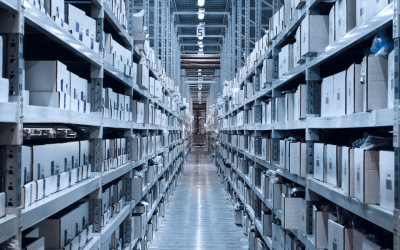Robotics is an area that is seeing a phenomenal level of growth across the warehouse operations world.
To the outsider, not versed in technology applied within warehouses, when you hear the term robotics one would usually think about depictions from movies or TV programmes of humanoid type machines, moving items in a way similar to a person, but this is not how technology has developed for warehousing robotics.
In factories and production, with regular and consistent motion requirements that can be programmed into a machine for conducting many repetitive tasks, we see robots of the kind many people may recognise that may typically have what may be described as an articulated arm that might move and swivel and conduct repetitive tasks. Think of a car production line and we’re sure you get the gist. This is perfect for those type of operations, where precision robotics can outpace human operatives with greater degree of accuracy. In that circumstance, this is the perfect kind of use for that type of robotics.
The robotics that are currently sweeping through warehouses across both the UK, and the world are actually much more a kin to what people may recognise from what they may see in gardens, where some may use robotic lawnmowers, or even in the home, where some will use robotic, autonomous vacuum cleaners. Where is the similarity one may ask? Well, to put it simply, the majority of robotics technology in use in warehousing are essentially small guided circular bases or discs with a platform for holding boxes and a small screen for operative interaction. Each one of the autonomous mobile discs (or ‘bots’) can typically carry one or two average sized boxes or tote bins around the warehouse to wherever the warehouse control system needs them to be.
The robots are performing a very perfunctory task of simply taking the legwork out of warehouse operations, and we mean that almost literally. Robots are being used simply to save humans from walking around nearly as much as they would typically be expected to do on what is known as the ‘traditional pick walk’.
When delivering warehouse consultancy projects, where we are tasked to analyse operative performance and productivity, we are often finding that upwards of 75% of the time it takes a person to carry out a set of picking tasks can be time spent purely walking, or in some cases, riding a truck, from one location to another.
That location could be at the start of the pick walk, where the operator may collect the empty boxes or totes, to the first location they need to pick product from, or it could be inter-pick location walking, or depositing the picked items to the completed orders station or pack station, depending on the solution in place. Only a small amount of the actual operative time spent physically picking the customer order.
That is where the benefit of these types of robotic picking solutions comes in. Pickers can be zoned into small discrete areas of the warehouse where each picker will work with many different robotic vehicles to gradually fill the totes or cartons being presented to them by the robots. Once the picking task is complete, the robot takes the product away, and the picker only has to travel a short distance to where the next available robot is waiting to be picked into.
In essence, this is a very basic use of technology, but one where the industry has rightly not attempted to over engineer the solutions.
This level of technology is proving to be extremely popular with those organisations that have a product mix suited to this level of robotics, but that is the key question: what types of business are suited to this type of robotics?
Usually, the applications where we see robotics having the best impact are in those sectors where customer orders are typically relatively small and light, or the product itself is relatively small and light. This type of solution works very well in clothing, pharmaceuticals, e-commerce and light FMCG applications.
This type of robotic solution is not currently suitable for heavier industry or high volume FMCG. The current limitations on robotics are driven by the payload capacity and run time of each robot. Typically, the type of robot in use in warehouse fulfilment have a load carrying capacity of no more than 50 KG. The higher the amount of KG put onto the robot, the less runtime can be accessed from the robot and therefore more robots per unit of dispatch are required.
However…watch this space, as the technology is developing all the time, and we expect improvements to come in battery life and robot capacity increases. We only have to look at the pace of change in battery technology being driven by the move towards electric vehicles to see that batteries will get smaller, more efficient and have greater life and therefore greater capacity to carry more product as time moves on.
At ASCALi, we fully recognise and believe that this type of warehouse robotics will grow and spread across many industries over the years to come.
Where we are less certain on the likely growth of robotics in warehousing is in the actual picking of orders and product. Whilst there are applications in the marketplace that can very quickly and accurately, assemble customer orders from product presented by more traditional robotics machines, they are currently very developmental, and at the very top end of the cost bracket, making benefits cases harder to prove.
Where companies may offer a large SKU bases, the challenge in picking with robotics is how to present the items for picking to the robots themselves. Once the items are presented, there will undoubtedly be a means of robotically picking different types of product, but that mix may prove challenging (such as heavy and light products) or products with different shapes and sizes.
There are automated methods to present (usually toted) products to robotic picking stations, but as per the robots themselves, this automation can prove to be highly expensive and out of reach of many organisations.
Where our team of warehouse consultants and SME specialists can see further additional growth in robotics is simply those repetitive tasks that may happen at the start and end of picking activity. Carton direction, tote transfer either onto robots or operative carts, box sealing, labelling and put-wall sortation could easily be conducted by robotic equipment. The key challenge to overcome is how to sensibly minimise human involvement in the process whilst maintaining equipment efficiency.
Whilst all of these areas will likely grow over time, the one thing that is certain is that labour availability is generally not going to significantly improve, and all the while that is the case, the cost for human operatives is only going to go up. This will continue to drive towards more automated and robotic solutions, and we would encourage all businesses, large or small to be open to the investment choices that could help position them to deliver efficient, warehouse solutions and optimised customer service.
Ascali provides Expert supply chain and logistics consulting solutions for its clients, we are sure that we could provide expert support to help your business develop its robotics and automation solutions. For more information, please use the contact us form below, or just give us a call on +44(0)1242 800 650 and a member of our experienced team will be happy to help.


